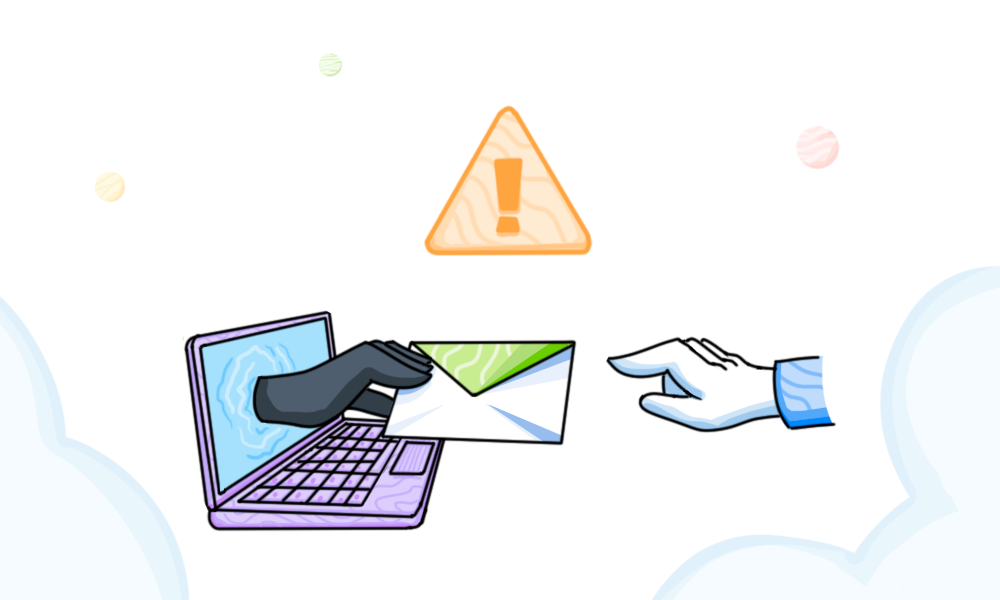Email security has become crucial since people are influenced to buy a product or service through marketing email. People are getting digital day by day. They prefer to purchase anything online. So for the marketer, email is the most effective marketing communication channel with customers. According to a Smith-Harmon survey, the Forbes – business magazine article shows that 76% of customers have made purchase decisions from an email marketing message. That is why marketing emails are the biggest target of hackers nowadays.
What is email security?
Email security is a term that refers to implementing different techniques to prevent email-based security threats or hacker attacks. It is also a process of securing an email’s content and protecting the hacker’s email account takeover. Moreover, email security can be defined as defending against malware, spam or phishing attacks and minimizing the data threats to both the email sender and receivers.
Present status of email security threats
Day by day, the security threats regarding email marketing are rapidly increasing. Lots of email marketers are greatly affected because of cybercriminals. So the present situation is disturbing.
Cybercriminals targeted 41% of organizations with an email-related phishing attempt.
According to Mimecast’s email security 2024 report.
So it is evident that organizations’ email security threats are rapidly increasing. It also indicates that hackers can easily target any small business organization or individual. Big organizations have improved their own Artificial Intelligence (AI) and Machine Learning (ML) to boost their in-house security system. But for small companies, it is much more costly to maintain an in-house security system. Therefore, prevention is a better option for any organization than facing any significant email security threats.
Four email security threats
Several email security threats can potentially be harmful to you or your customers. These include email scams, spoofing, malware, and phishing. All these four types of threats have different characteristics. We will now dive into deeper each of these:
1Scams
Email scams are the most common email threats. Scams are harmful to both email senders and receivers. Cybercriminals may hack any organization’s or individual’s sensitive information using scams. They can send scam emails to email marketers or receivers. Moreover, modern email scammers are becoming smarter nowadays. They are constantly creating new, uncommon email scams which are more challenging to spot. A scam usually hurts any email marketer’s campaign very severely. Marketers can quickly lose the trust of their customers. When email receivers experience many frauds from email senders, they typically cease purchasing their goods or services. In a nutshell, hackers’ primary objective is to steal subscribers’ sensitive financial information.
Although there are several ways to identify a hacker, if the hacker is a professional, it might be tough for anyone to identify them. Therefore, the marketer and the receiver must be aware of this situation. The email marketer should use a valid email address with the proper brand name. On the other hand, email receivers must avoid any suspicious emails at any cost.
2Spoofing
Email spoofing is a widely used technique by cybercriminals to trick the email receiver. Spoofing refers to the forgery of emails that make emails in the receiver’s eye as if they came from a genuine brand or company rather than a cybercriminal. It will trick the email receiver, increasing the chance of opening a fraudulent email. So the main motive of hackers for creating this type of fake email is to get access to the payment information of the recipient.
A cybercriminal can change any element of an email to make it look authentic. Changing the email sender’s name is one of the most common ways. Here the hacker falsifies the real sender’s identity to trick the email receiver. Hackers are always one step ahead. They research the sender first and then change the email’s origin according to the email receiver. Before modifying the email’s origin to make it seem more authentic to the receiver, they research the email recipient’s persona very tactfully, probably from social media.
3Malware
Malware includes viruses, trojan horses, spyware, adware, keyloggers, and ransomware. Any malware email can be hazardous as it can destroy your email campaign. Also, it is an alarming threat to your reputation. Additionally, your email receiver can face massive data-stealing threats. In worst-case scenarios, sometimes a malware link or file (which may have been attached to the email) can hack someone’s entire computer system.
4Phishing
Phishing is currently the most threatening hacking tactic that cybercriminals often use to steal any email recipient’s sensitive data. An email marketer can also be significantly affected by these phishing attempts. If their subscribers encounter unwanted phishing attacks, their trust in the email marketer might decrease eventually. They may even switch the marketer’s brand to avoid further unwanted situations. However, nowadays, hackers are becoming very intelligent. They are using the ‘spear phishing’ technique. It refers to a cleverly personalized phishing email that can grab the victim’s attention more quickly and easily. The Spear phishing technique is difficult to recognize by the email receiver.
Here are some key phishing elements that a hacker can attach to an email to commit cybercrime:
- A phishing link (e.g., unfamiliar webpage URL)
- A CTA button (with phishing hyperlink)
- An image (with phishing hyperlink)
- Request confidential information via email (bank details, PIN, passwords, etc.)
- Call for urgent action (e.g., using the “immediately download/open” word in email)
- Suspicious attachments (ISO, ZIP, EXE, IMG, GIF, or Document file)
Some preventional security practices
There is a common phrase – “prevention is better than cure.” In terms of email security, prevention is better than facing any security threat. Because if you face any unwanted security threat, solving it is time-consuming and costly. So why don’t you try focusing on stopping the threats instead? Here are some tips –
Educate your subscribers
You must first and foremost educate your subscribers about potential dangers regarding email security. Subscribers are those who agree to receive your marketing emails, and later on, they may become your potential customers. In most cases, hackers often solely target subscribers. Because they know that the general population is less informed about security risks, you must educate your customers as an email marketer. Consequently, you may host seminars, send emails with advice and informative content, create useful blogs, update your FAQ pages and social media profiles, and share other people’s authentic security blogs, bulletins, etc. For example, you may post an article on your company’s social media page about ‘never access emails from public Wi-Fi.’ Thus, almost half of your effort will accomplish if your customer knows how to avoid suspicious emails.
Verify your email list
An email list is required before running an email campaign. But it is not unusual that a hacker’s account can also be inside the email list. It is not essential how extensive your email list is, but it should be valid. So, always check and update your email list. Do not add or buy an email list from any sources. If you find any suspicious email addresses in your list, make them blacklisted at once. In a word, you have to ensure that everyone on your email list is known to you.
Email Authentication
This should be vital when you want to build a brand reputation among your customers. Email authentication helps you reduce your spam rate and phishing attacks. When email authentication protocols are followed, emails are less likely to fall prey to spam, spoofing, and phishing assaults. Moreover, this process gives total control of monitoring to the email marketer on how their customers are using their domain. There are four email verification standards: DKIM, SPF, DMARC, and PTR. These verification standards ensure email authenticity. By implementing these four standards, a marketer can authorize to send only legitimate emails on behalf of their domain.
Using email security software
Last but not least, you should use any well-known security software. Not only you but also your customers have to use it from their end too to ensure security. A cybercriminal may attack either you or your customer to steal sensitive information. Many cybersecurity companies provide top-notch email security software. This software will protect against phishing attacks and help to block hackers’ any potential attempts on the system and computer storage. You may check G2’s comparison guidelines regarding which email security software is best for you.
Conclusion
Sadly, many email marketers make mistakes by underestimating the significance of email security practices. Although, it is the most crucial practice that must be followed and monitored throughout email marketing. Moreover, if you care to teach your customers how to avoid losing their sensitive information to hackers, your relationship with the customers will gradually increase in the long term. But before educating your customers, you must learn thoroughly about it first. So, don’t ignore this important factor at any cost. You can build a positive brand image in the competitive marketplace by educating your customers about email security. And, over time, you may develop a solid brand reputation.



 Contents
Contents
